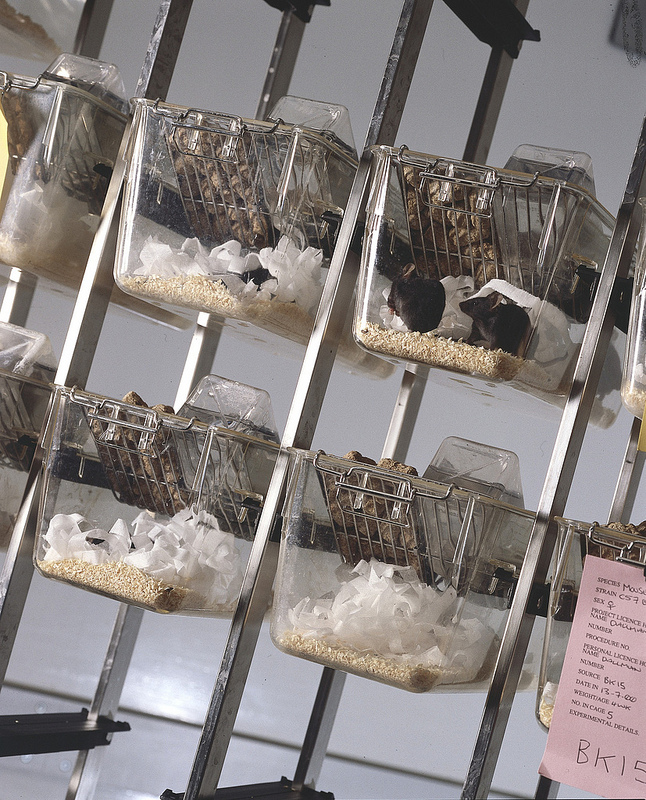Animal Testing: The Cruel and Outdated Practice
December 6, 2017
“It’s okay because it’s research.”
This is what many people say about animal testing, but in reality it is a cruel and inhumane practice.
Imagine your pets: your cats, dogs, guinea pigs, hamsters, bunnies. Imagine them living their lives in a cold laboratory with other innocent animals. None of these animals are allowed to run, play, explore, love, or be loved. They can’t do what animals do best.
They are forced to endure dangerous chemical treatments and scientists place chemicals on their skin and in their eyes to see the maximum effects possible before these poor animals have to be put out of their misery.
Apparently being taken to a laboratory and stuffed in a cold, metal cage isn’t enough. They are forced to swallow harsh chemicals and are used as test subjects. These chemicals aren’t just temporarily painful, though. They cause seizures, burning, swelling, bleeding, and eventually death. From the moment they enter the lab they are guaranteed a terrible and painful death. These tests are ruthless and offer no sympathy or acknowledgement that the test animals are living creatures.
Although there are many industries where this takes place, the cosmetics industry is a major offender. When there are alternatives that would be much more effective and accurate, why do cosmetic companies continue to test on helpless animals?
One motive for testing on animals is to be able to sell products in China. Since animal testing is required for imported cosmetic products to be sold in China, many brands opt to sell products there anyway, and ignore the pleas for a cruelty-free makeup and cosmetic industry.
According to CNBC, change in the mandatory testing is slowly occurring. In late 2016, the Chinese government allowed “safety data collected through a non-animal test method, the 3T3 phototoxicity assay, which measures the safety of a chemical after exposure to light,” although they haven’t stated if this method will continue to be allowed.
Since China is a major market for many products, companies are willing to sacrifice the lives of thousands of animals to meet the requirements of the Chinese market, which the authorities are hesitant to change because the safety of the people is the responsibility of the government. However, animal testing is not necessary to determine safety for humans, as the European Union has shown, in now going several years with a complete ban on animal testing.
Although removing their products from China would cause brands to potentially lose a lot of money, no one is forcing them to continue testing on animals. They are choosing to do so.
There are a few things a company can do to avoid animal testing:
- Use advanced technology. Advanced technology allows scientists and laboratories to “isolate human cells — often left over from cosmetic procedures like tummy tucks — to make 3D models of skin. They also make models that are similar to eyes, even lungs.” Using this technology offers safe and often more accurate alternatives to animal testing.
- Create products with previously tested ingredients. Many companies insist on creating products with new ingredients, even though it means new testing. They could be using thousands of previously tested, safe ingredients.
- Focus on other markets. Selling products in China requires animal testing, but other countries do not require this cruel practice. If they choose not to sell in China, they may lose money in the short term, but could help make it up by widening their market to other countries and using cheaper and more modern methods of testing, like 3D models.
Although this method of testing has been the go-to for many years, organizations like PETA and the Humane Society are working to end it. There have been many successes that these organizations can be proud of.
In 2013, the European Union, along with Israel and Norway, banned all animal testing. In 2014, other countries such as India and Brazil also banned animal testing. This trend continued in 2015 when more countries, like the US, Canada, South Korea, and New Zealand, joined the fight against animal testing by attempting to pass legislation to institute bans immediately or in the near future. (However, these efforts failed in the US.) And in 2016, Australia created a ban that went into effect in July 2017.
The world has made enormous progress to encourage cruelty-free practices, but there is still more work to do.
Not only do major cosmetic companies continue to test on animals, but other major industries also use animal testing.
Though it may seem that we have no control and can’t directly help, we can contribute to this effort by not purchasing products from brands that test on animals. An easy way to do this is to only buy products that have a cruelty free logo.
In addition to boycotting these brands, we can help the cause by supporting the legislation that would place a permanent ban on animal testing in the United States. For instance, the Humane Society offers a way to reach out to representatives to voice your support of the Humane Cosmetics Act.
As of July 2017, many cosmetic companies continue to test on animals. Some of these major companies are:
- NARS
- Mac
- Maybelline
- L’Oreal
- Clinique
- Benefit
If people stop purchasing products by these brands, and instead support cruelty-free alternatives, companies will eventually join the cruelty-free movement and help save the lives of innocent animals.
Creative Commons photo source: https://www.flickr.com/photos/90500915@N05/8223128477/






Rebecca Ly • Dec 6, 2017 at 11:41 pm
I really appreciate this article. I really hate how cosmetic companies still continue to test on animals even though there are already hundreds–if not thousands of already tested products that are safe. I wish companies such as MAC, Benefit, etc. would stop testing on animals. Interestingly, I had a very similar topic for my research paper; I researched about testing on animals like chimpanzees for medical advancements. Unfortunately, there aren’t really any better alternatives to testing on animals (as of right now) because otherwise, we would have to test on humans..which can be equally bad or worse. However, that doesn’t mean that there isn’t anything for us to do about this issue. In regard to cosmetics, we can stop purchasing products from these companies, send the companies emails about our concerns, tell our friends and family about the issue, etc.. Sure, our voices might seem insignificant now but if we all work toward something, then I’m sure they’ll be a day where animal testing for products is no longer happening. Let’s end animal suffering together! 🙂 <3
Derek Wong • Dec 6, 2017 at 9:28 pm
While I absolutely agree with your points in the context of cosmetics research. I have to disagree with the idea that all animal testing is inherently unethical. To be sure, there are always people and laboratories that treat test subjects inhumanely. However, the vast majority of research animals, especially in academia as opposed to corporate research, are treated quite well. For instance, the lights in the room are tightly controlled to best simulate the natural circadian rhythms of the animal. It is actually forbidden to enter a room with animal subjects in it after the lights have gone out. The animals are never starved and have all of their basic needs met. In order to even begin animal testing, there are dozens of regulatory hoops to jump through. When I worked in a lab, I had to attend an animal ethics course. That was for an intern position where I worked with mice for less than an hour a day. Now imagine how much more training you would have to undergo to actually be certified to run a lab with animal test subjects in it.
The point you make in this article is very important. All suffering should be minimized, animal or otherwise. However, there are legitimate uses for animal testing in other contexts, such as medical research where the only other viable test subjects would be primates or humans.